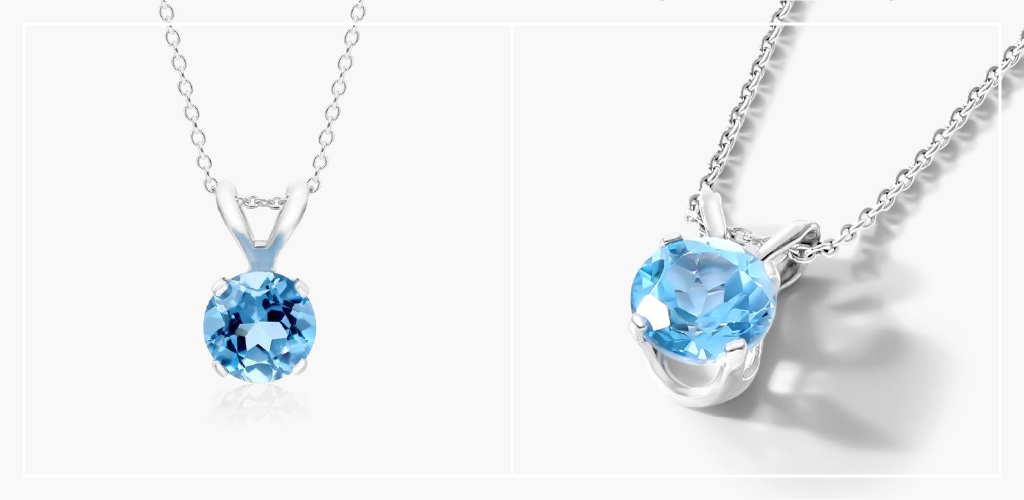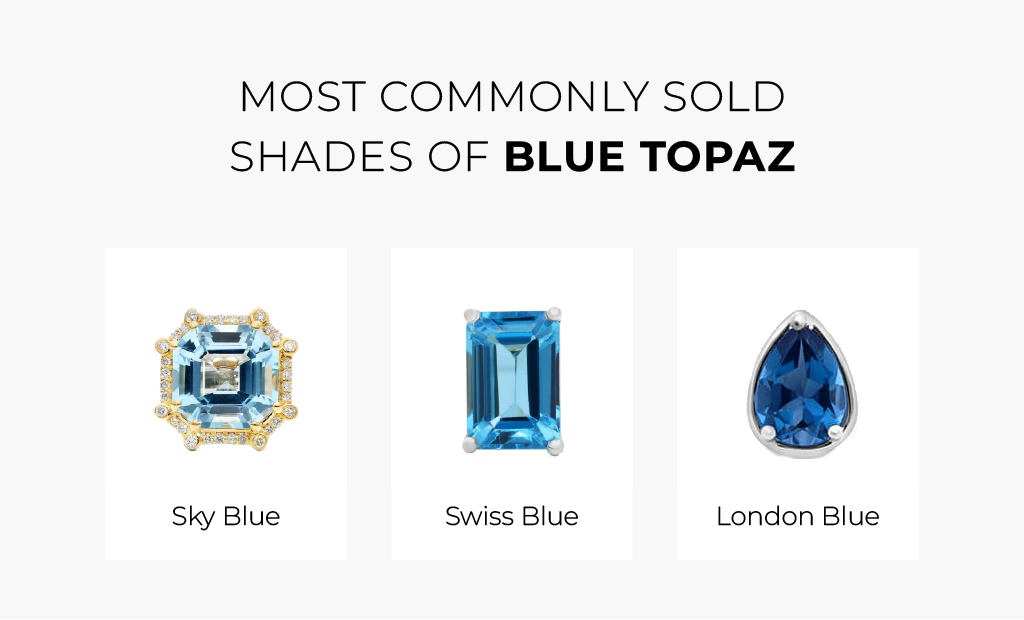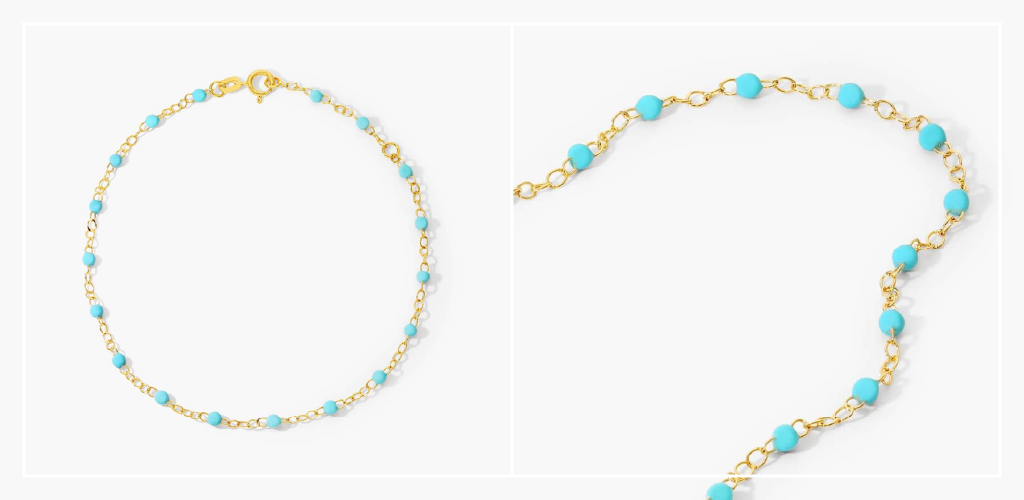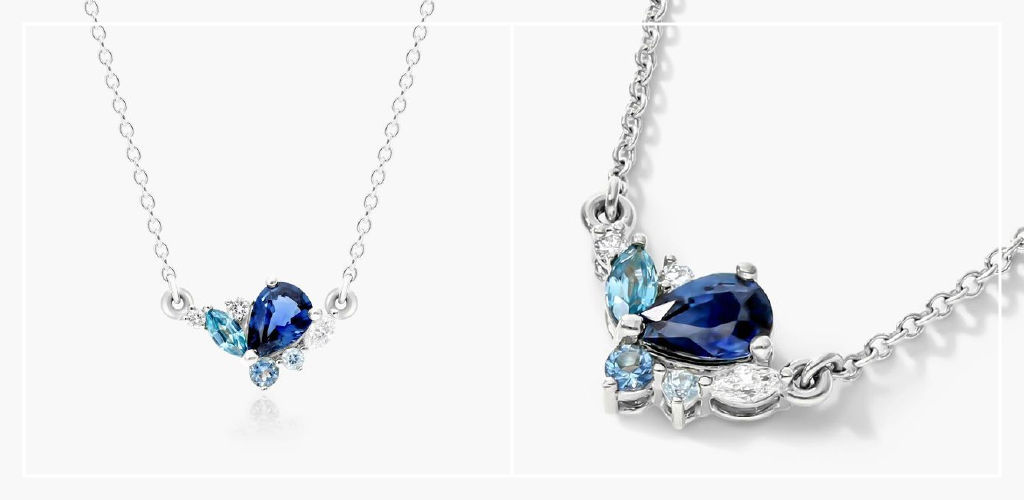
If you have a loved one with an upcoming December birthday, it’s important to know the differences between its four gemstones.
After all, December birthstone necklaces, earrings, and rings can become heirloom pieces that last lifetimes. You’ll want to choose one that best reflects your loved one and your relationship with them.
Below, we’ll cover each gemstone’s meaning, history, color, and care tips to help you find and fall in love with the best December stone for you.
The December birthstones are blue topaz, turquoise, tanzanite, and zircon. Though all four birthstones are blue, reflecting the winter season, each is a slightly different shade. Each stone also has its own history and thus a unique set of associated meanings.
Let’s overview the meaning, color, and key traits of each stone below.
| Meaning | Color | Key Traits | |
| Blue Topaz | Strength, love, and protection | Light to dark blue | Hardest, durable |
| Turquoise | Protection, fertility, and good health | Blue-green with dark matrix (veins) | Soft and porous |
| Tanzanite | Tranquility, rarity, and new beginnings | Deep purplish blue | Rarest and most expensive |
| Blue Zircon | Good dreams, prosperity, and wisdom | Light blue to greenish blue | High refractive index (sparkle) |
Fun Fact: December is one of the six months with two or more birthstones, though it’s the only month to have more than three.

Topaz is a common gemstone that comes in a range of colors, including yellow and pink. But thanks to blue topaz‘s affordability and beautiful range of blue shades, it’s become an extremely popular choice for December birthstone jewelry.
Multiple ancient civilizations prized blue topaz for its protective properties, including the Aztecs and ancient Egyptians, who thought the gemstone could help prevent injuries and other illnesses. Some people think topaz is named for the Greek island Topazios, while others believe that the name topaz comes from the Sanskrit words “topas” or “tapaz,” which mean fire.
Today, whether set in a timeless blue topaz necklace or a modern statement piece, this gemstone continues to charm with its effortless elegance.
Like most gemstones, the blue topaz birthstone is brimming with symbolism. In Ancient Greece, topaz was believed to give one strength. Originally worn to bring protection, this gemstone is now also thought to bring affection and is often given as a symbol of one’s love. Blue topaz is also associated with fourth wedding anniversaries.
A blue topaz has an unmistakably icy blue color, with little to no trace of green. Jewelers commonly sell this gemstone in three different shades:
Fun Fact: When mined, blue topaz often actually appears clear. Professional gemologists then add radiation and heat to bring out the rich blue color. While there is naturally occurring blue topaz that appears light blue when mined, it’s quite rare.

Blue topaz is quite durable, ranking 8 on the Mohs Hardness Scale, but you should still care for it by washing and storing it properly.
Its durability makes blue topaz a great choice for everyday jewelry. However, despite its hardness, blue topaz can also be brittle, and some color variations, such as London blue, are more easily scratched. Therefore, you should still exercise caution when wearing pieces featuring this stone.
Follow these tips to keep your blue topaz protected and shining all year long:

Turquoise, the next December birthstone, is known for its striking blue-green color and the beautiful dark veins that often ribbon through it. This gemstone forms when acidic groundwater from rain seeps into the earth and reacts with other minerals in the veins of rocks or nestled in pockets of clay.
One of the oldest known gemstones, turquoise has been prized in many civilizations throughout history. Researchers have found turquoise beads that date back to 5,000 BCE in ancient Mesopotamia, and Chinese craftsmen made turquoise talismans over 3,000 years ago.
Though it is now found across the globe, turquoise has been mined in the Nishapur district of Iran for more than 1,000 years. The stone derives its name from the French word for Turkish, because turquoise made its way to Europe through Turkish traders in the 17th century.
The ancient Egyptians connected turquoise with fertility and vegetation. For the Aztecs, it was more valuable than gold, so they gave turquoise offerings to fertility goddesses.
Turquoise is opaque, with colors ranging from green to blue. The higher its copper content, the bluer it appears, while the higher its iron content, the greener it appears.
The gemstone often, but not always, has darker veins, known as the “matrix,” running across it. These veins are remnants of the host rock in which the turquoise formed.
The Nishapur region’s turquoise is especially prized for its intense blue shade, dubbed “robin’s egg blue,” “sky blue,” and “Persian blue.” Some trade professionals now use these terms to describe the quality of turquoise regardless of where it is mined.
Turquoise is on the softer side, rating a 5-6 on the Mohs hardness scale, so it’s especially important to treat it with care. It is also a very porous stone, though it is sometimes treated professionally with resin or epoxy to improve its durability.
Here are some care tips to keep your turquoise jewelry in beautiful shape:

Tanzanite is a recently discovered gemstone and the most recently added December birthstone. With a gorgeous, deep purplish blue color, it is the darkest and rarest of the four December birthstones. It is an intensely rich variety of the mineral Zoisite, and is only found in one known location on Earth.
Tanzanite was discovered in 1967 in the Merelani Hills of Tanzania, which sit at the foot of Mount Kilimanjaro. In 1968, Tiffany & Co. began to market the new stone, giving it the name Tanzanite in honor of its country of origin.
The Merelani Hills region is still the only place in the world where Tanzanite is commercially mined. This rare and modern stone steadily rose in popularity after its discovery, and it became a birthstone for December in 2002.
Because it’s a relatively recent discovery, Tanzanite doesn’t carry as many historical or culturally significant meanings as the other December birthstones. However, some have started to associate it with tranquility, rarity, and new beginnings.
Tanzanite is a blue-purple variety of a mineral called zoisite. Its colors range from light violet to a rich and velvety burgundy. Tanzanite has a unique property called pleochroism, which means that its color can appear different (blue, red, or purple) depending on the direction you view it from. Typically, the darker it is, the more valuable the tanzanite.
Fun Fact: Naturally forming tanzanite appears partially brownish, so professionals usually heat treat it to enhance its blue-purple color.
On the Mohs hardness scale, tanzanite comes in at a 6 to 7. It is generally resistant to tarnishing from exposure to chemicals and light. However, high heat can still damage the stone. Here are some tips for taking care of a tanzanite piece:

Zircon is a gemstone with brilliance and fire comparable to that of diamonds. People often confuse it with cubic zirconia, but the two are chemically distinct. Cubic zirconia is a human-made diamond simulant, while Zircon is a natural mineral that forms in metamorphic rocks or magma.
Zircon is the oldest material on Earth; geologists have estimated zircon mined in Australia to be around 4.3 billion years old. Today, it’s commonly mined in Sri Lanka, Australia, Vietnam, Cambodia, and Myanmar.
Because zircon’s chemical structure changes over long periods of time, scientists treat older ones like time capsules, using them to study the origins of the planet.
Though it can be difficult to trace zircon’s history in ancient cultures, gemologists believe that the name comes from the Persian “zargun,” meaning “gold-colored,” probably referencing the yellow variety of zircon.
In medieval Europe, blue zircon was believed to ward off evil spirits and aid in restful sleep. It was also highly popular during the Victorian era, when it was valued for symbolizing wisdom, calmness, and love.
Zircon comes in many colors, including red, yellow, and green, as well as a colorless variety, but it’s the blue variety that serves as a birthstone for December. Blue zircon is created by heat-treating naturally brownish zircon in an oxygen-free atmosphere. The resulting stone’s color can range from light blue to greenish blue.
Blue zircon also has a high refractive index, meaning that it bends light at a greater angle than other gemstones. This gives it an exceptional brightness and fire, once cut.
Blue zircon comes in at a 6 to 7.5 on the Mohs hardness scale. While scratch-resistant, zircons can also be brittle, so strong impacts can cause them to break. Here are some care tips to keep in mind for this stone:
Each of the four December birthstones — blue topaz, turquoise, tanzanite, and blue zircon — offers its own unique properties, hues, and symbolism.
Whether you are shopping for yourself, have a family member with a December birthday, or are proposing with a birthstone engagement ring, you have a spectacular variety of blue stones to choose from.
James Allen is your committed destination for your life’s most important jewelry purchases. With elevated style and honest pricing, we offer a variety of stylish and classic gemstones. Check out our gemstone buying guide or start browsing our curated selection of birthstone jewelry.
December has four birthstones: blue zircon, blue topaz, tanzanite, and turquoise. Of all the months, December has the most birthstone options. All four December birthstones are blue-colored, reflecting the winter season.
The exact historical origin of blue topaz is unknown, as it has been found throughout history. Today, blue topaz is mined in Sri Lanka, Brazil, Mexico, Nigeria, and the U.S. It is the official state gem of Texas.
It is not known exactly why December has so many birthstones. Some believe that it was to add more affordable options. Birthstones can evolve with new gemstone discoveries and commercial offerings.
In 1912, the National Association of Jewelers standardized the unofficial American birthstones, combining customs with gemstones that would be practical for jewelry companies to sell. In 1952, Jewelry Industry Council of America updated the list, adding zircon to December’s list. Tanzanite was added in 2002.
Tanzanite is the most valuable of the four December birthstones. It is the rarest, since it’s only mined in a specific region of Tanzania. That’s why it’s also the most expensive.
Blue topaz is the most durable December birthstone for everyday wear. Of all the December birthstones, blue topaz is the hardest on the Mohs hardness scale at an 8.